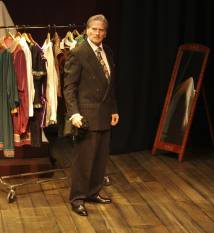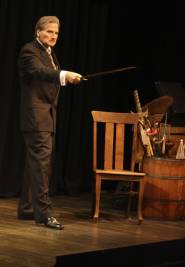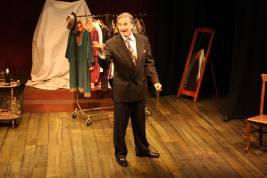
Southern California musical theater star Gordon Goodman brings to life stage-and-screen legend John Barrymore in William Luce’s Barrymore, the virtual one-man-show that won its originator Christopher Plummer the Tony and could well earn Goodman equivalent recognition when L.A. award season comes around.
 Barrymore’s days of glory as silent film idol, his stardom in “talkies” like Grand Hotel and Dinner At Eight, and his critical acclaim playing Richard III and Hamlet on Broadway are long past when Luce introduces us to an alcoholic “Jack” on the stage of an empty New York theater a mere month before his death on May 29, 1942 at the age of 60.
Barrymore’s days of glory as silent film idol, his stardom in “talkies” like Grand Hotel and Dinner At Eight, and his critical acclaim playing Richard III and Hamlet on Broadway are long past when Luce introduces us to an alcoholic “Jack” on the stage of an empty New York theater a mere month before his death on May 29, 1942 at the age of 60.
The washed-up star has come to the theater for a last-minute rehearsal-for-one of what he hopes will be a Broadway comeback as Richard III, but ribaldry and reminiscences almost immediately take the place of running lines with offstage prompter Frank.
Bawdy limericks (like one about a certain Yolanda in Kalamazoo who got “seized by the nape and humped by an ape as she sighed ‘What a heavenly screw.’”) alternate with recollections of his famous siblings Lionel and Ethel, his “lunatic … brute” of a father, Hollywood comedy legend W.C Fields, Barrymore’s four ex-wives (including second wife Blanche, who “had the face of a Romney portrait and the soul of a marine”), his fellow carouser playwright Edward “Ned” Sheldon, and a 1922 Broadway performance as Hamlet that revitalized and redefined his career.
 Act Two has Barrymore reminiscing about the Hollywood cinematographer who magically “got rid of these sweet-breads under my eyelids and this moose’s lavalier,” the scene-stealing ways of older brother Lionel, and the death of his father at the age of 51 from “a lethal combination of absinthe and syphilis.”
Act Two has Barrymore reminiscing about the Hollywood cinematographer who magically “got rid of these sweet-breads under my eyelids and this moose’s lavalier,” the scene-stealing ways of older brother Lionel, and the death of his father at the age of 51 from “a lethal combination of absinthe and syphilis.”
Along the way, prompter Frank struggles to little avail to keep Jack on track, the faded star’s vocabulary seeming at times to be limited to a single word, “Line.”
Los Angeles audiences have likely not seen Luce’s Barrymore live on stage since Christopher Plummer brought the play to the Ahmanson in 1998, a year after winning a trifecta of Best Actor awards: the Tony, the Drama Desk, and the Outer Critics Circle.
And no wonder. Christopher Plummer’s shoes are hard ones to fill.
 Fortunately, director extraordinaire Janet Miller found just such a shoe-filler in Goodman, who not only looks the part, he acts the living daylights out of it, giving us not only the washed-up drunk Barrymore had become at the age of 60 (watch how Goodman’s hands keep shaking ever so subtly, the result of decades of heavy drinking) but glimpses into his onetime greatness in a pair of exquisitely rendered Shakespeare soliloquies, Hamlet’s “To be or not to be,” and a Glouster soliloquy from King Henry VI, Third Part. (And Goodman has a terrific way with a punch line to boot.)
Fortunately, director extraordinaire Janet Miller found just such a shoe-filler in Goodman, who not only looks the part, he acts the living daylights out of it, giving us not only the washed-up drunk Barrymore had become at the age of 60 (watch how Goodman’s hands keep shaking ever so subtly, the result of decades of heavy drinking) but glimpses into his onetime greatness in a pair of exquisitely rendered Shakespeare soliloquies, Hamlet’s “To be or not to be,” and a Glouster soliloquy from King Henry VI, Third Part. (And Goodman has a terrific way with a punch line to boot.)
As the offstage prompter Frank, a boyishly-voiced Matt Franta gets not only to cue Barrymore but to prompt the star’s reminiscences of days gone by and comment on them, a performance a lesser actor might phone in but which Franta plays with verve and spunk—and in costume, as we discover at curtain call.
 Katherine Barrett’s endlessly varied lighting design is one of the best you’ll see all year, working in collaboration with Goodman to keep audience interest high. (A sequence in which Barrymore recalls climbing “the long, dimly-staircase” of his childhood home, aka “the tomb of the Capulets,” is particularly striking.) Scenic designer Scott Walewski has us believing that the stage of the Greenway Court Theatre on Fairfax is that of a venerable Broadway palace. Costume designers Kathy Gillespie and Barbara Weisel give us Barrymore both in elegant street clothes and in Richard III tunic and tights.
Katherine Barrett’s endlessly varied lighting design is one of the best you’ll see all year, working in collaboration with Goodman to keep audience interest high. (A sequence in which Barrymore recalls climbing “the long, dimly-staircase” of his childhood home, aka “the tomb of the Capulets,” is particularly striking.) Scenic designer Scott Walewski has us believing that the stage of the Greenway Court Theatre on Fairfax is that of a venerable Broadway palace. Costume designers Kathy Gillespie and Barbara Weisel give us Barrymore both in elegant street clothes and in Richard III tunic and tights.
Barrett doubles as stage manager, assisted by Rebecca Schroeder. Barrymore is produced by Miller’s Good People Theater Company in association with Greenway Arts Alliance.
Though the name Barrymore is doubtless now most associated with John’s granddaughter Drew, William Luce, Janet Miller, and above all Gordon Goodman remind us in whose illustrious footsteps the 21st Century film star is following. “Jack” may no longer have been The Great Barrymore when we meet him in 1942, but Goodman is great indeed in 2013.
Greenway Court Theatre, 544 N. Fairfax Blvd., West Hollywood.
www.GoodPeopleTheaterCo.org
–Steven Stanley
November 16, 2013
Photos: Kimberly Fox
Tags: Good People Theater Company, Gordon Goodman, Greenway Court Theatre, Janet Miller, John Barrymore, Los Angeles Theater Review, William Luce


 Since 2007, Steven Stanley's StageSceneLA.com has spotlighted the best in Southern California theater via reviews, interviews, and its annual StageSceneLA Scenies.
Since 2007, Steven Stanley's StageSceneLA.com has spotlighted the best in Southern California theater via reviews, interviews, and its annual StageSceneLA Scenies.







 COPYRIGHT 2025 STEVEN STANLEY :: DESIGN BY
COPYRIGHT 2025 STEVEN STANLEY :: DESIGN BY